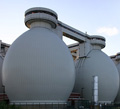
Ultrasonics for Oil, Gas and Renewable Fuels
Ultrasonics for Oil, Gas and Renewable Fuels
Oil prices and greenhouse gases as well as the sustainability of fuel sources became a focal point of interest in the oil & gas industry. Hielscher ultrasonic devices are used in research facilities and processing plants for many applications.
Ultrasonic devices made by Altrasonic are used for many processes, such as mixing, dispersing, homogenizing and dissolving of powders into liquids, as well as for the production of stable emulsions. This flexibility opens up many applications in the production of fuels. Read on to discover the potential of ultrasonics for fossil and renewable fuels.

NOx-Reduction by Oil/Water-Emulsification
Introducing water into the fuel combustion has been proven to lower the NOx emissions. Water added to the fuel lowers the combustion temperature due to water evaporation. When the water evaporates, the surrounding fuel is vaporized too -increasing the surface area of the fuel. The ultrasonic emulsification is an effective means for generating fine-size fuel/water-emulsions.

Sonochemical Desulfurization
An innovative alternative to hydrodesulfurization is the ultrasonically assisted desulfurization. High local temperatures resulting from ultrasonic cavitation change the chemical reaction kinetics of the desulfurization process. This effect allows for alternative – less expensive – catalysts or alternative desulfurization chemistry to be used.

Biodiesel from Vegetable Oil and Animal Fat
Biodiesel is a renewable fuel – an alternative to diesel fuel made from petroleum. Biodiesel is made by transesterification from sources, such as vegetable oil, algae oil, animal fats or grease. The manufacturing of biodiesel involves the catalytic reaction with alcohol. Ultrasonic mixing of the oil, fat or grease with the alcohol improves the reaction speed and yield significantly. This reduces investment and operational costs.

Bioethanol from Starch and Sugar
Bioethanol is used as a green alternative to gasoline. It is made from corn, wheat, potatoes, sugar cane, rice and other grains by fermentation. Yeast is used to ferment the starch and sugars found in these crops to ethanol. Ultrasonic disintegration of cellular structures and extraction of intracellular material reduces the particle size and exposes a much larger surface area to enzymes during liquefaction. This improves the bioavailability of starch and sugar and results in faster and more complete fermentation leading to more ethanol.

Biogas from Waste and Sludge
The processing of organic waste, sewage sludge, muck and manure in aerobic or anaerobic digesters converts the organic material into biogas. Ultrasonic disintegration of the organic material prior to digestion alters the material structure, and releases and activates enzymes. This improves the digestion of the organic material leading to faster processing, more gas and less residual sludge. This in turn increases the capacity of existing digesters and reduces disposal costs.
Previous :
Ultrasonic machining (USM)Next :
Ultrasonics for Biodiesel Processing© Copyright: 2024 Hangzhou Altrasonic Technology Co.,Ltd All Rights Reserved

IPv6 network supported
Scan to wechat
